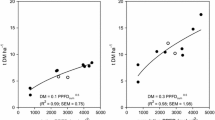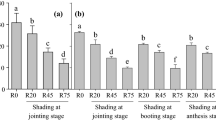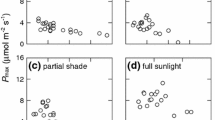Abstract
There is growing interest in using switchgrass (Panicum virgatum L.) as a biofuel intercrop in forestry systems. However, there are limited data on the longevity of intercropped bioenergy crops, particularly with respect to light availability as the overstory tree canopy matures. Therefore, we conducted a greenhouse study to determine the effects of shading on switchgrass growth. Four treatments, each with different photosynthetically active radiation (PAR) levels, were investigated inside the greenhouse: control (no shade cloth, 49 % of full sunlight), low (under 36 % shade cloth), medium (under 52 % shade cloth), and heavy shade (under 78 % shade cloth). We determined the effect of shading from March to October 2011 on individually potted, multi-tillered switchgrass transplants cut to a stubble height of 10 cm. In the greenhouse, there was a reduction in tiller number, tiller height, gas exchange rates (photosynthesis and stomatal conductance), leaf area, above- and belowground biomass and light-use efficiency with increasing shade. Total (above- and belowground) biomass in the control measured 374 ± 22 compared to 9 ± 2 g pot−1 under heavy shade (11 % of full sunlight). Corresponding light-use efficiencies were 3.7 ± 0.2 and 1.4 ± 0.2 g MJ−1, respectively. We also compared PAR levels and associated aboveground switchgrass biomass from inside the greenhouse to PAR levels in the inter-row regions of a range of loblolly pine (Pinus taeda L.) stands from across the southeastern United States (U.S.) to estimate when light may limit the growth of intercropped species under field conditions. Results from the light environment of loblolly pine plantations in the field suggest that switchgrass biomass will be significantly reduced at a loblolly pine leaf area index between 1.95 and 2.25, which occurs on average between ages 6 and 8 years across the U.S. Southeast in intensively managed pine plantations. These leaf area indices correspond to a 60–65 % reduction in PAR from open sky.




Similar content being viewed by others
References
Albaugh JM, Sucre EB, Leggett ZH, Domec J-C, King JS (2012) Establishment success of switchgrass in an intercropped forestry system on the Lower Coastal Plain of North Carolina, USA. Biomass Bioenergy 46:673–682
Albaugh JM, Domec J-C, Maier C, Sucre EB, Leggett ZH, King JS (2014) Gas exchange and stand-level estimates of water use and gross primary productivity in an experimental pine and switchgrass intercrop forestry system on the Lower Coastal Plain of North Carolina, USA. Agric For Meteorol 192–193:27–40
Balasko JA, Smith D (1971) Influence of temperature and nitrogen fertilization on the growth and composition of switchgrass (Panicum virgatum L.) and timothy (Phelum pratense L.). Agron J 63:853–856
Bellow JG, Nair PKR (2003) Comparing common methods for assessing understory light availability in shaded-perennial agroforestry systems. Agric For Meteorol 114:197–211
Blazier M (2014) Perfect pair for biofuel: switchgrass and trees. Inside Agrofor 22:4–5
Blazier MA, Clason TR, Vance ED, Leggett Z, Sucre EB (2012) Loblolly pine age and density affects switchgrass growth and soil carbon in an agroforestry system. For Sci 58:485–496
Blinn CE, Albaugh TJ, Fox TR, Wynne RH, Stape JL, Rubilar RA, Allen HL (2012) A method for estimating deciduous competition in pine stands using Landsat. South J Appl For 36:71–78
Burner DM, Brauer DK (2003) Herbage response to spacing of loblolly pine trees in a minimal management silvopasture in southeastern USA. Agrofor Syst 57:69–77
Cannell MGR (1989) Physiological basis of wood production: a review. Scand J For Res 4:459–490
Casal JJ, Deregibus VA, Sanchez RA (1985) Variations in tiller dynamics and morphology in Lolium multiflorum Lam. vegetative and reproductive plants as affected by differences in red/far-red irradiation. Ann Bot 56:553–559
Casal JJ, Sanchez RA, Deregibus VA (1987) Tillering responses of Lolium multiflorum plants to changes of red/far-red ratios typical of sparse canopies. J Exp Bot 38:1432–1439
Clason TR (1999) Silvopastoral practices sustain timber and forage production in commercial loblolly pine plantations of northwest Louisiana, USA. Agrofor Syst 44:293–303
Dale VH, Kline KL, Wiens J, Fargione J (2010) Biofuels: implications for land use and biodiversity. Biofuels and sustainability reports. Ecological Society of America, Ithaca
Devkota A, Jha PK (2010) Effects of different light levels on the growth traits and yield of Centella asiatica. Middle-East J Sci Res 5:226–230
Dohleman FG, Heaton EA, Leakey ADB, Long SP (2009) Does greater leaf-level photosynthesis explain the larger solar energy conversion efficiency of Miscanthus relative to switchgrass? Plant Cell Environ 32:1525–1537
Downing M, Walsh M, McLaughlin S (1996) Perennial grasses for energy and conservation. In: Lockeretz W (ed) Environmental enhancement through agriculture. Tufts University, Medford, pp 217–224
Ehrenreich JH (1960) Useable forage under pine stands. U.S. Department of Agriculture Forest Service, Central States Forest Experiment Station, Station Note 142, Columbus, OH
Fuentes RG, Taliaferro CM (2002) Biomass yield stability of switchgrass cultivars. Trends New Crops New Uses 2002:276–282
Garten CT Jr, Smith JL, Tyler DD, Amonette JE, Bailey VL, Brice DJ, Castro HF, Graham RI, Gunderson CA, Izaurralde RC, Jardine PM, Jastrow JD, Kerley MK, Matamala R, Mayes MA, Metting FB, Miller RM, Moran KK, Post WM III, Sands RD, Schadt CW, Phillips JR, Thomson AM, Vugteveen T, West TO, Wullschleger SD (2010) Intra-annual changes in biomass, carbon, and nitrogen dynamics at 4-year old switchgrass field trials in west Tennessee, USA. Agric Ecosyst Environ 136:177–184
George N, Tungate K, Hobbs A, Fike J, Atkinson A (2008) A guide for growing switchgrass as a biofuel crop in North Carolina. North Carolina Solar Center, North Carolina State University, Raleigh, NC
Hatch MD (1992) C4 photosynthesis: an unlikely process full of surprises. Plant Cell Physiol 33:333–342
Heaton EA, Voigt T, Long SP (2004) A quantitative review comparing the yields of two candidate C4 perennial biomass crops in relation to nitrogen, temperature and water. Biomass Bioenergy 27:1–30
Heaton EA, Dohleman FG, Long S (2008) Meeting US biofuel goals with less land: the potential of Miscanthus. Glob Change Biol 14:1–15
Kephart KD, Buxton DR, Taylor SE (1992) Growth of C3 and C4 perennial grasses under reduced irradiance. Crop Sci 32:1033–1038
Kiniry JR, Tischler CR, van Esbroeck GA (1999) Radiation use efficiency and leaf CO2 exchange for diverse C4 grasses. Biomass Bioenergy 17:95–112
Kiniry JR, Johnson M-VV, Bruckerhoff SB, Kaiser JU, Cordsiemon RL, Harmel RD (2012) Clash of the titans: comparing productivity via radiation use efficiency for two grass giants of the biofuel field. Bioenerg. Res. 5:41–48
Kozlowski TT, Pallardy SG (1997) Physiology of woody plants, 2nd edn. Academic Press, London
Krall JP, Pearcy RW (1993) Concurrent measurements of oxygen and carbon dioxide exchange during light-flecks in maize (Zea mays L.). Plant Physiol 103:823–828
Landsberg JJ (1986) Physiological ecology of forest production. Academic Press, London
Leight SA, Silander JA Jr (2006) Differential responses of invasive Celastrus orbiculatus (Celastraceae) and native C. scandens to changes in light quality. Am J Bot 93:972–977
Li F, Meng P, Fu D, Wang B (2008) Light distribution, photosynthetic rate and yield in a Paulownia-wheat intercropping system in China. Agrofor Syst 74:163–172
Linder S (1987) Responses to water and nutrients in coniferous ecosystems. In: Schulze ED, Wolfer HZ (eds) Potentials and limitations of ecosystems analysis. Ecological studies. Springer-Verlag, Berlin, pp 180–202
Long SP (1999) Environmental responses. In: Sage RF, Monson RK (eds) C4 plant biology. Academic Press, San Diego, pp 215–249
Ma Z, Wood CW, Bransby DI (2000) Impacts of soil management on root characteristics of switchgrass. Biomass Bioenergy 18:105–112
Madakadze I, Coulman BE, Stewart K, Peterson P, Samson R, Smith DL (1998) Phenology and tiller characteristics of big bluestem and switchgrass cultivars in a short growing season area. Agron J 90:489–495
Mathers HM (2003) Summary of temperature stress issues in nursery containers and current methods of protection. HortTechnology 13:617–624
McLaughlin SB, Kszos LA (2005) Development of switchgrass (Panicum virgatum) as a bioenergy feedstock in the United States. Biomass Bioenergy 28:515–535
McLaughlin S, Bouton J, Bransby D, Conger B, Ocumpaugh W, Parrish D, Taliaferro C, Vogel K, Wullschleger S (1999) Developing switchgrass as a bioenergy crop. Perspect New Crops New Uses 1999:282–299
Mitchell R, Vogel KP, Sarath G (2008) Managing and enhancing switchgrass as a bioenergy feedstock. Biofuels Bioprod Biorefin 2:530–539
Monteith JL (1981) Climatic variation and growth of crops. Q J R Met Soc 107:749–774
Munsell JF, Fox TR (2010) An analysis of the feasibility for increasing woody biomass production from pine plantations in the southern United States. Biomass Bioenergy 34:1631–1642
Parrish DJ, Fike JH (2005) The biology and agronomy of switchgrass for biofuels. Crit Rev Plant Sci 24:423–459
Pearcy RW (1990) Sunflecks and photosynthesis in plant canopies. Annu Rev Plant Physiol Plant Mol Biol 41:421–453
Peri PL, Lucas RJ, Moot DJ (2007) Dry matter production, morphology and nutritive value of Dactylis glomerata growing under different light regimes. Agrofor Syst 70:63–79
Pitman WD (2000) Adaptation of tall-grass prairie cultivars to west Louisiana. J Range Manage 53:47–51
Sage RF, Pearcy RW (2000) The physiological ecology of C4 photosynthesis. In: Leegood RC, Sharkey TD, von Caemmerer S (eds) Photosynthesis: physiology and metabolism. Kluwer Academic, Dordrecht, pp 497–532
Sampson DA, Allen HL (1998) Light attenuation in a 14-year-old loblolly pine stand influenced by fertilization and irrigation. Trees 13:80–87
Sampson DA, Wynne RH, Seiler JR (2008) Edaphic and climatic effects on forest stand development, net primary production, and net ecosystem productivity simulated for Coastal Plain loblolly pine in Virginia. J Geophys Res 113:1–14
Sanderson MA (1992) Morphological development of switchgrass and kleingrass. Agron J 84:415–419
Sanderson MA, Reed RL (2000) Switchgrass growth and development: water, nitrogen, and plant density effects. J Range Manage 53:221–227
Sanderson MA, Reed RL, McLaughlin SB, Wullschleger SD, Conger BV, Parrish DJ, Wolf DD, Taliaferro C, Hopkins AA, Ocumpaugh WR, Hussey MA, Read JC, Tischler C (1996) Switchgrass as a sustainable bioenergy crop. Bioresour Technol 56:83–93
SAS Institute (2000) SAS Software version 9.2. SAS Institute, Cary, NC
Sharkey TD, Seemann JR, Pearcy RW (1986) Contribution of metabolites of photosynthesis to postillumination CO2 assimilation in response to lightflecks. Plant Physiol 82:1063–1068
Skeel VA, Gibson DJ (1996) Physiological performance of Andropogon gerardii, Panicum virgatum, and Sorghastrum nutans on reclaimed mine spoil. Restor Ecol 4:355–367
Smith H (1982) Light quality, photoperception, and plant strategy. Annu Rev Plant Physiol 33:481–518
Spokas K, Forcella F (2006) Estimating hourly incoming solar radiation from limited meteorological data. Weed Sci 54:182–189
Tolbert VR, Schiller A (1996) Environmental enhancement using short-rotation woody crops and perennial grasses as alternatives to traditional agricultural crops. In: Proceedings of a conference on environmental enhancement through agriculture, Boston, MA, pp. 209–216
Trócsányi ZSK, Fieldsend AF, Wolf DD (2009) Yield and canopy characteristics of switchgrass (Panicum virgatum L.) as influenced by cutting management. Biomass Bioenergy 33:442–448
Van Esbroeck GA, Hussey MA, Sanderson MA (1997) Leaf appearance rate and final leaf number of switchgrass cultivars. Crop Sci 37:864–870
Vance E (2010) Current and potential capabilities of wood production systems in the southeastern U.S. Biomass Bioenergy 34:1629–1630
Varella AC, Moot DJ, Pollack KM, Peri PL, Lucas RJ (2011) Do light and alfalfa responses to cloth and slatted shade represent those measured under an agroforestry system? Agrofor Syst 81:157–173
Vogel KP (2004) Switchgrass. In: Moser LE, Burson BL, Sollenberger LE (eds) Warm-season (C4) grasses. American Society of Agronomy Inc.; Crop Science Society of America, Inc.; Soil Science Society of America, Inc., Madison, pp 561–588
Will RE, Narahari NV, Shiver BD, Teskey RO (2005) Effects of planting density on canopy dynamics and stem growth for intensively managed loblolly pine stands. For Ecol Manage 205:29–41
Wilson JR, Ludlow MM (1991) The environment and potential growth of herbage under plantations. In: Shelton HM, Stür WW (eds) Forages for plantation crops. Australian Centre for International Agriculture Research Proceedings No. 32, Canberra, pp. 10–24
Wright LL (1994) Production technology status of woody and herbaceous crops. Biomass Bioenergy 6:191–209
Wullschleger SD, Sanderson MA, McLaughlin SB, Biradar DP, Rayburn AL (1996) Photosynthetic rates and ploidy levels among populations of switchgrass. Crop Sci 36:306–312
Zan CS, Fyles JW, Girouard P, Samson RA (2001) Carbon sequestration in perennial bioenergy, annual corn and uncultivated systems in southern Quebec. Agric Ecosyst Environ 86:135–144
Acknowledgments
We acknowledge North Carolina State University, Weyerhaueser Company, Catchlight Energy LLC (a Chevron and Weyerhaeuser joint venture) and the Forest Productivity Cooperative for funding and support. We are grateful to Mr. Sam Brake from the North Carolina Biofuels Center for advice and for supplying the switchgrass seedlings, and to Dr. Chris Maier from the Forest Service for access to unpublished data. Samuel Honeycutt assisted with the biomass harvest and sample processing. Additional funding for research was provided by United States Department of Agriculture NIFA-AFRI Sustainable Bioenergy grant number 2011-67009-20089.
Author information
Authors and Affiliations
Corresponding author
Appendix
Appendix
See Table 8.
Rights and permissions
About this article
Cite this article
Albaugh, J.M., Albaugh, T.J., Heiderman, R.R. et al. Evaluating changes in switchgrass physiology, biomass, and light-use efficiency under artificial shade to estimate yields if intercropped with Pinus taeda L.. Agroforest Syst 88, 489–503 (2014). https://doi.org/10.1007/s10457-014-9708-3
Received:
Accepted:
Published:
Issue Date:
DOI: https://doi.org/10.1007/s10457-014-9708-3




